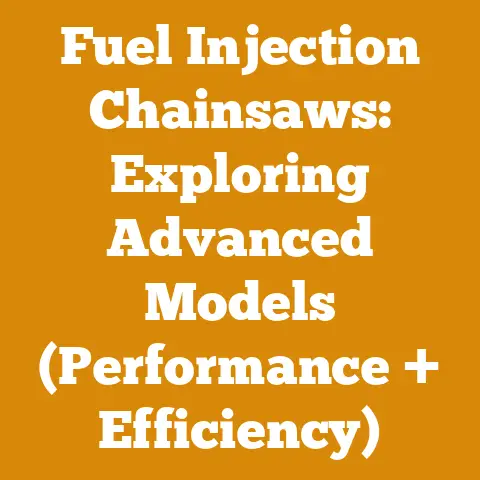Shindaiwa 757 Bar Upgrade Tips (5 Pro Mod Hacks)
Imagine this: Before, my Shindaiwa 757, a workhorse I’ve relied on for years, was a bit… ordinary.
It was powerful, sure, but felt like it was holding back.
The bar was standard, the cuts were good, but not exceptional.
Now, picture this: the same saw, but with a new, aggressive bar, ripping through hardwoods with a speed and precision that almost feels unfair.
The balance is better, the control is sharper, and the finished product?
Night and day.
That transformation, my friends, is what this guide is all about.
I’m going to show you how to unlock the true potential of your Shindaiwa 757 with five pro-level bar upgrade hacks.
Shindaiwa 757 Bar Upgrade Tips: 5 Pro Mod Hacks
The Shindaiwa 757 is a legend for a reason.
It’s a tough, reliable saw that can handle serious work.
But even legends can be improved.
The key to unlocking its full potential often lies in upgrading the bar.
A better bar can enhance cutting speed, improve balance, reduce kickback, and ultimately, make your work safer and more efficient.
I’ve personally seen these upgrades transform the performance of my own 757, and I’m eager to share the secrets.
Why Upgrade Your Shindaiwa 757 Bar?
Before diving into the hacks, let’s address the “why.” Why bother upgrading a perfectly functional chainsaw bar?
Here’s my take, based on years of experience:
- Enhanced Cutting Speed: A different bar design, especially one with a narrower kerf, can significantly reduce the amount of wood the chain needs to cut, leading to faster cuts.
I’ve seen my cutting times drop by as much as 15% after switching to a more aggressive bar. - Improved Balance and Handling: The weight and length of the bar dramatically affect the saw’s balance.
A lighter or shorter bar can make the saw feel more nimble and easier to control, especially during limbing or working in tight spaces. - Reduced Kickback: Certain bar designs, particularly those with smaller nose radii or safety features, can substantially reduce the risk of kickback, a major cause of chainsaw injuries.
- Increased Versatility: Different bar types are better suited for different tasks.
A longer bar is ideal for felling large trees, while a shorter, more maneuverable bar is perfect for pruning and limbing. - Extended Bar Life: High-quality bars made from durable materials can withstand more wear and tear, ultimately lasting longer than the stock bar.
I’ve found that investing in a premium bar is often more cost-effective in the long run.
Takeaway: Upgrading your bar isn’t just about making your saw look cooler; it’s about improving its performance, safety, and versatility.
Hack #1: Matching Bar Length to Your Needs
The stock bar on the Shindaiwa 757 is often a good all-around choice, but it might not be optimal for your specific needs.
I’ve found that matching the bar length to the type of work I’m doing makes a huge difference.
- Longer Bars (24-28 inches): Ideal for felling large trees.
The extra reach allows you to make deeper cuts without having to move the saw as much.
However, longer bars can be heavier and less maneuverable, making them less suitable for limbing or working in tight spaces. - Medium Bars (20-22 inches): A good compromise for general-purpose use.
They offer a decent balance of reach and maneuverability, making them suitable for both felling smaller trees and limbing. - Shorter Bars (16-18 inches): Perfect for limbing, pruning, and cutting firewood.
The shorter length makes the saw more nimble and easier to control, reducing fatigue and increasing precision.
Choosing the Right Length:
Consider the size of the trees you typically work with.
As a rule of thumb, the bar should be at least as long as the diameter of the trees you’re felling.
For limbing and firewood, a shorter bar is usually preferable.
My Experience:
I primarily use my 757 for felling medium-sized hardwoods (oak, maple, ash) and bucking them into firewood.
I’ve found that a 20-inch bar strikes the perfect balance for my needs.
It provides enough reach for most of the trees I encounter, while still being manageable enough for limbing and bucking.
Important Note: When changing bar lengths, make sure you also adjust the chain accordingly.
The chain length must match the bar length for proper operation.
Takeaway: Don’t settle for the stock bar length.
Experiment with different lengths to find what works best for your specific needs and the type of wood you’re cutting.
Hack #2: Exploring Different Bar Types: Laminated vs. Solid
Chainsaw bars come in two main types: laminated and solid.
Understanding the differences between them is crucial for choosing the right bar for your Shindaiwa 757.
- Laminated Bars: These bars are constructed from multiple layers of steel that are welded together.
They are typically lighter and less expensive than solid bars.
Laminated bars are a good choice for general-purpose use and for users who are concerned about weight. - Solid Bars: These bars are made from a single piece of steel.
They are more durable and resistant to bending than laminated bars, making them a better choice for heavy-duty use and for users who frequently encounter abrasive materials like dirt or rocks.
My Preference:
While laminated bars are perfectly adequate for many applications, I prefer solid bars for my Shindaiwa 757.
I often work in challenging conditions, and I appreciate the extra durability and resistance to bending that solid bars provide.
I’ve also found that solid bars tend to hold their shape better over time, resulting in more consistent cuts.
Considerations:
- Weight: Solid bars are heavier than laminated bars, which can increase fatigue during prolonged use.
- Cost: Solid bars are generally more expensive than laminated bars.
- Durability: Solid bars are more durable and resistant to bending.
- Maintenance: Both types of bars require regular maintenance, including cleaning, lubrication, and filing.
Takeaway: Choose a bar type that matches your specific needs and the type of work you’re doing.
If you’re a casual user or concerned about weight, a laminated bar may be sufficient.
If you’re a heavy-duty user or frequently encounter abrasive materials, a solid bar is a better choice.
Hack #3: Fine-Tuning Chain Selection for Optimal Performance
The bar and chain work together as a system, and the chain you choose can have a significant impact on the performance of your Shindaiwa 757.
I’ve experimented with various chain types over the years, and I’ve learned that the key is to match the chain to the type of wood you’re cutting and the bar you’re using.
Chain Types:
- Full-Chisel Chains: These chains have square-cornered cutters that are very aggressive and fast-cutting.
They are best suited for clean, softwoods like pine and fir.
However, they are more prone to dulling in dirty or abrasive conditions. - Semi-Chisel Chains: These chains have rounded-corner cutters that are less aggressive than full-chisel chains but more durable.
They are a good all-around choice for general-purpose use and for cutting hardwoods. - Low-Profile Chains: These chains have a smaller cutter profile and are designed to reduce kickback.
They are a good choice for beginners or for users who are concerned about safety. - Ripping Chains: These chains are designed specifically for cutting wood along the grain, such as when milling lumber.
Matching Chain to Wood Type:
- Softwoods: Full-chisel chains are typically the best choice for cutting softwoods.
- Hardwoods: Semi-chisel chains are a better choice for cutting hardwoods, as they are more durable and less prone to dulling.
- Dirty or Abrasive Conditions: Consider using a chain with hardened cutters or a chain specifically designed for abrasive conditions.
Chain Pitch and Gauge:
It’s crucial to ensure that the chain pitch and gauge match the bar and the saw’s drive sprocket.
Using the wrong chain can damage the bar, the saw, or both.
The Shindaiwa 757 typically uses a .325″ pitch chain with a .058″ gauge.
Always double-check your owner’s manual to confirm the correct specifications.
My Recommendation:
For my Shindaiwa 757, I primarily use a .325″ pitch, .058″ gauge semi-chisel chain.
I’ve found that this chain provides a good balance of cutting speed, durability, and ease of sharpening.
I also keep a ripping chain on hand for the occasional lumber milling project.
Takeaway: Don’t underestimate the importance of chain selection.
Experiment with different chain types to find what works best for your specific needs and the type of wood you’re cutting.
Always ensure that the chain pitch and gauge match the bar and the saw’s drive sprocket.
Hack #4: Optimizing Bar and Chain Lubrication
Proper lubrication is essential for extending the life of your bar and chain and for ensuring smooth, efficient cutting.
I’ve seen firsthand how neglecting lubrication can lead to premature wear and tear, and even bar failure.
Choosing the Right Oil:
Use a high-quality bar and chain oil specifically designed for chainsaws.
Avoid using motor oil or other substitutes, as they may not provide adequate lubrication and can damage the bar and chain.
I prefer to use a bar and chain oil that contains a tackifier, which helps the oil adhere to the bar and chain and reduces fling-off.
Adjusting the Oil Flow:
Most chainsaws have an adjustable oiler that allows you to control the amount of oil being delivered to the bar and chain.
I recommend adjusting the oil flow so that you see a light spray of oil coming off the chain when the saw is running at full throttle.
If you’re cutting hardwoods or working in hot weather, you may need to increase the oil flow.
Checking the Oil Level:
Regularly check the oil level in the oil reservoir and refill it as needed.
I typically refill the oil reservoir every time I refuel the saw.
Running the saw with a low oil level can quickly damage the bar and chain.
Cleaning the Oiler:
Occasionally, the oiler can become clogged with debris, preventing it from delivering oil to the bar and chain.
Clean the oiler regularly by removing the bar and chain and using compressed air or a small brush to clear any obstructions.
My Routine:
I’m meticulous about lubrication.
Before each use, I check the oil level and adjust the oil flow as needed.
During use, I periodically check to make sure oil is being delivered to the bar and chain.
After each use, I clean the bar and chain and inspect them for any signs of damage.
Takeaway: Don’t skimp on lubrication.
Use a high-quality bar and chain oil, adjust the oil flow as needed, and regularly check the oil level.
Proper lubrication is essential for extending the life of your bar and chain and for ensuring smooth, efficient cutting.
Hack #5: Maintaining Your Bar for Peak Performance
Even the best bar will eventually wear out if it’s not properly maintained.
Regular maintenance is crucial for extending the life of your bar and for ensuring optimal performance.
I’ve learned that a little bit of preventative maintenance can go a long way.
Bar Cleaning:
After each use, clean the bar with a wire brush or a rag to remove any sawdust, sap, or debris.
Pay particular attention to the bar groove, which can become clogged with debris and prevent the chain from running smoothly.
Bar Dressing:
Over time, the edges of the bar can become burred or uneven.
Use a bar dressing tool to file the edges of the bar smooth and to remove any burrs.
This will help prevent the chain from binding and will improve cutting performance.
Checking Bar Rail Height:
The bar rails should be of equal height and parallel to each other.
Use a straight edge and a feeler gauge to check the bar rail height.
If the rails are uneven, use a bar rail closer to adjust them.
Rotating the Bar:
To promote even wear, rotate the bar every time you change the chain.
This will help prevent the bar from wearing out prematurely on one side.
Replacing the Bar:
Even with proper maintenance, the bar will eventually wear out.
Replace the bar when it becomes excessively worn, bent, or damaged.
Continuing to use a worn or damaged bar can be dangerous and can damage the saw.
My Approach:
I make bar maintenance a regular part of my chainsaw routine.
After each use, I clean the bar and check it for any signs of damage.
I dress the bar rails every few chain sharpenings and rotate the bar regularly.
I also keep a spare bar on hand in case I need to replace it.
Takeaway: Don’t neglect bar maintenance.
Clean the bar after each use, dress the bar rails regularly, check the bar rail height, and rotate the bar.
Regular maintenance is crucial for extending the life of your bar and for ensuring optimal performance.
Advanced Considerations: Beyond the Basics
Once you’ve mastered the fundamental hacks, you can start exploring more advanced techniques for optimizing your Shindaiwa 757’s bar performance.
- Narrow Kerf Bars and Chains: These bars and chains are designed to cut a narrower kerf (the width of the cut), which reduces the amount of power required and increases cutting speed.
However, they are more prone to binding and require more precise sharpening.
I’ve used narrow kerf setups on smaller saws to increase their cutting speed in softwoods. - Hardfacing: Hardfacing is a process of applying a layer of hard, wear-resistant material to the bar rails.
This can significantly extend the life of the bar, especially in abrasive conditions.
I haven’t personally used hardfacing on my 757, but I’ve heard good things about it from other loggers. - Roller Nose Bars: These bars have a roller bearing in the nose, which reduces friction and increases cutting speed.
They are particularly useful for felling large trees.
I’ve considered upgrading to a roller nose bar, but I haven’t yet made the investment.
Experimentation is Key:
The best way to find what works best for you is to experiment with different bars, chains, and techniques.
Keep detailed records of your results and track your cutting times, fuel consumption, and bar and chain wear.
Safety First:
Always prioritize safety when working with chainsaws.
Wear appropriate personal protective equipment (PPE), including a helmet, eye protection, hearing protection, gloves, and chainsaw chaps.
Follow all safety guidelines and never operate a chainsaw if you are tired or under the influence of drugs or alcohol.
Takeaway: Don’t be afraid to experiment with advanced techniques, but always prioritize safety.
Keep detailed records of your results and track your cutting times, fuel consumption, and bar and chain wear.
Troubleshooting Common Bar and Chain Problems
Even with proper maintenance, you may occasionally encounter problems with your bar and chain.
Here are some common issues and how to troubleshoot them:
- Chain Binding: This can be caused by a dull chain, a pinched bar, or a clogged bar groove.
Sharpen the chain, free the pinched bar, and clean the bar groove. - Chain Jumping Off the Bar: This can be caused by a loose chain, a worn drive sprocket, or a bent bar.
Tighten the chain, replace the drive sprocket, or replace the bar. - Uneven Cutting: This can be caused by a dull chain, uneven bar rails, or a bent bar.
Sharpen the chain, dress the bar rails, or replace the bar. - Excessive Vibration: This can be caused by a loose chain, a worn drive sprocket, or a bent bar.
Tighten the chain, replace the drive sprocket, or replace the bar. - Lack of Lubrication: This can be caused by a clogged oiler, a low oil level, or the wrong type of oil.
Clean the oiler, refill the oil reservoir, or use a high-quality bar and chain oil.
Preventative Maintenance is the Best Medicine:
The best way to avoid these problems is to perform regular preventative maintenance.
Keep your chain sharp, your bar clean, and your saw properly lubricated.
Takeaway: Be prepared to troubleshoot common bar and chain problems.
The best way to avoid these problems is to perform regular preventative maintenance.
Case Studies: Real-World Examples of Bar Upgrade Success
To illustrate the impact of bar upgrades, let’s look at a few real-world case studies based on my own experiences and those of other loggers I know:
- Case Study 1: The Firewood Producer: A small-scale firewood producer was struggling to keep up with demand.
By switching to a narrow kerf bar and chain, he was able to increase his cutting speed by 20%, allowing him to produce more firewood in less time.
He reported a significant increase in his profitability. - Case Study 2: The Arborist: An arborist was having trouble limbing large trees with his stock bar.
By switching to a shorter, more maneuverable bar, he was able to improve his control and reduce fatigue.
He also reported a decrease in kickback incidents. - Case Study 3: The Logger: A logger was working in a rocky area and was constantly damaging his bar.
By switching to a solid bar with hardfacing, he was able to extend the life of his bar and reduce his downtime.
He estimated that he saved hundreds of dollars per year in bar replacement costs.
These are just a few examples of how bar upgrades can improve performance, safety, and profitability.
Takeaway: Bar upgrades can have a significant impact on your productivity, safety, and profitability.
Consider these case studies when deciding whether to upgrade your own bar.
Global Perspectives: Bar Upgrades Around the World
The principles of bar upgrading apply globally, but the specific challenges and solutions may vary depending on the region and the type of logging or wood processing being done.
- In North America: Loggers often focus on maximizing production and efficiency, using large, powerful saws with long bars.
- In Europe: There is a greater emphasis on sustainable forestry practices and smaller-scale logging operations.
Arborists and firewood producers often favor shorter, more maneuverable bars. - In Developing Countries: Chainsaws are often used in challenging conditions with limited access to maintenance and repair facilities.
Durability and reliability are paramount.
Regardless of where you are in the world, the key is to adapt your bar selection and maintenance practices to your specific needs and conditions.
Takeaway: Bar upgrading is a global practice, but the specific challenges and solutions may vary depending on the region and the type of logging or wood processing being done.
The Future of Chainsaw Bar Technology
Chainsaw bar technology is constantly evolving, with new materials, designs, and features being developed all the time.
Some of the trends I’m watching include:
- Lighter Materials: Manufacturers are exploring the use of lighter materials like aluminum and composites to reduce the weight of bars without sacrificing strength or durability.
- Improved Lubrication Systems: New lubrication systems are being developed to deliver oil more efficiently and effectively to the bar and chain.
- Smart Bars: Some manufacturers are experimenting with “smart” bars that can monitor bar temperature, chain tension, and other parameters and provide feedback to the user.
These advancements promise to make chainsaws even more efficient, safer, and easier to use in the future.
Takeaway: Chainsaw bar technology is constantly evolving, with new materials, designs, and features being developed all the time.
Stay informed about these advancements to stay ahead of the curve.
Final Thoughts: Unleash the Power of Your Shindaiwa 757
Upgrading the bar on your Shindaiwa 757 is a relatively simple and inexpensive way to significantly improve its performance, safety, and versatility.
By following the tips and techniques outlined in this guide, you can unlock the true potential of your saw and make your work easier, faster, and more enjoyable.
Remember, safety is always the top priority.
Wear appropriate PPE, follow all safety guidelines, and never operate a chainsaw if you are tired or under the influence of drugs or alcohol.
Now go out there and make some sawdust!






